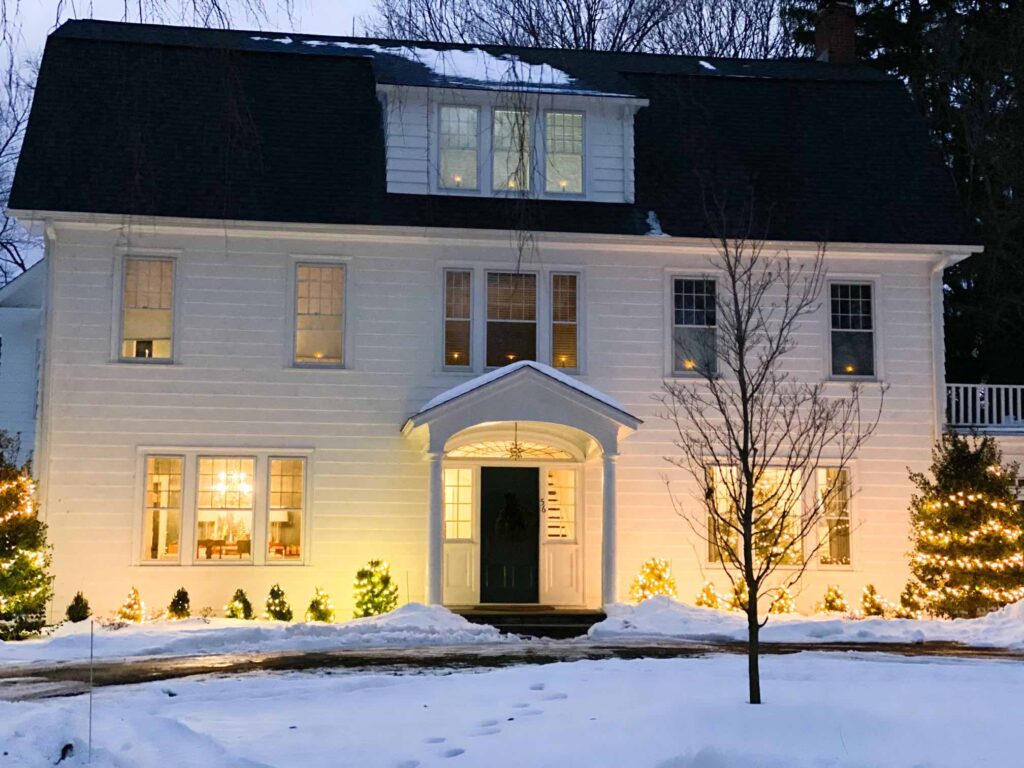The Olmsted House

This handsome home was built on land purchased in 1923 by Frances M. Olmsted, wife of Franklin H. Olmsted (reportedly a distant relative of the renowned landscape architect Frederick Law Olmsted) from Julia Finch Gilbert, wife of Cass Gilbert. The Gilberts owned large areas surrounding their country home, the former Keeler Tavern, which they called the Cannonball House. (It’s now the core of the Keeler Tavern Museum and History Center.)
The Olmsteds, newly arrived in Ridgefield, brought a familiar name but their connection to the local Olmste(a)ds is not known. Franklin Olmsted was a native of North Carolina and spent much of his business career in Japan. Their daughter, Frances Helen Olmsted, who was born in 1890 in Yokohama, Kanagawa, Japan, moved to Ridgefield with them and spent the rest of her life here. Also in residence with the Olmsteds was the senior Frances Olmsted’s sister, Miss Edith Otis.
According to Frances Helen Olmsted’s obituary in The Ridgefield Press, “The Olmsteds were interested in the Ridgefield Library and many other civic enterprises. After Mr. and Mrs. Olmsted died, Miss Olmsted built a smaller home for herself on Branchville Road. She lived there until she went to Altnacraig [a High Ridge mansion that had been converted to a nursing home] because of failing health.” She died on July 30, 1965.
The center hall colonial home of the Olmsteds, in a park-like setting, is on an accessway that once led to Hawk’s Nest, the estate of hotelier William S. Hawk, which was one of Ridgefield’s grandest before it burned to the ground in a spectacular fire in 1921. It’s believed that Battle of RIdgefield combatants passed through this area; a nearby house was said to have served as a hospital for injured British soldiers
In 1964, the Van Poznak family (Dr. Frederick, Joan, and their daughters Karen and Elissa) moved from Lounsbury Road to the 1923 Olmsted house off Branchville Road. Dr. Van Poznak was the police and fire surgeon for Ridgefield and a Fellow of the American College of Surgeons and Mrs. Van Poznak was active in numerous Ridgefield organizations. Dr. Van Poznak began volunteering aboard the hospital ship S.S. Hope; after several tours on the S.S. Hope, he closed his surgical practice in 1973 and the family moved to England.
The house then became the home of Charles and Sandra Tepfer. Mr. Tepfer, one of the founders of Temple Shearith Israel (now Congregation Shir Shalom), owned Tepfer Publishing and was former executive editor for the Nielsen Publishing Company and editor of Electronics Illustrated. He started one of the first publications that focused on cable television. The Tepfers, whose three children grew up here, moved to Westport after about 20 years in the house.
Richard and Deanne Mincer also enjoyed the house for about 20 years before moving to Florida. He had been the Emmy Award-winning producer of the Phil Donahue Show in Dayton, Ohio, a talk show believed to be the first in which audience members were invited to contribute questions and comments. Winner of five national Emmys, Mr. Mincer worked on the show for 18 years, most of the time as executive producer. He later worked on program development for Multimedia Inc. and produced The Rush Limbaugh Show.
Deanne Mincer’s career in Ridgefield centered on sharing the discipline of yoga, particularly with people who had special needs, whether physical or spiritual. She created a studio in the basement of this home where she taught class and led sessions for private clients, focusing on the healing power of yoga.
The current owners of the Olmsted House have spent the last decade restoring the original elements that remained, including the original front door and hardware as well as a leaded glass arc window. All of the original windows were returned to full working order using period-appropriate materials including cotton rope and copper weather stripping. The foyer and butler’s pantry light fixtures were restored, plaster walls were repaired and floors were refinished. The butler’s pantry with its original built-in, glass-paneled cabinets, which had long been painted over, was brought back to its original state, with the glass doors and original hardware lovingly restored by the homeowners, as were the original chestnut counter, bar sink and faucet.
As the original kitchen was no longer in place, the family looked to add modern functionality in a traditional way. Fir floors and a Connecticut chestnut wood island were used as period materials to help create a cohesive look. The soapstone sink was uncovered in the basement and is believed to have been used in the summer kitchen that once was part of the home’s lower level. The current owners chronicle their restoration work and proudly call this 1923 village house home.
Audio Story narrated by Rob Coloney.



